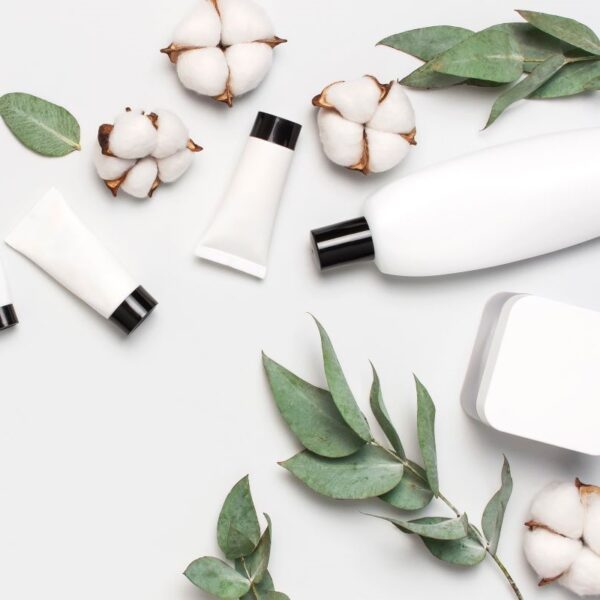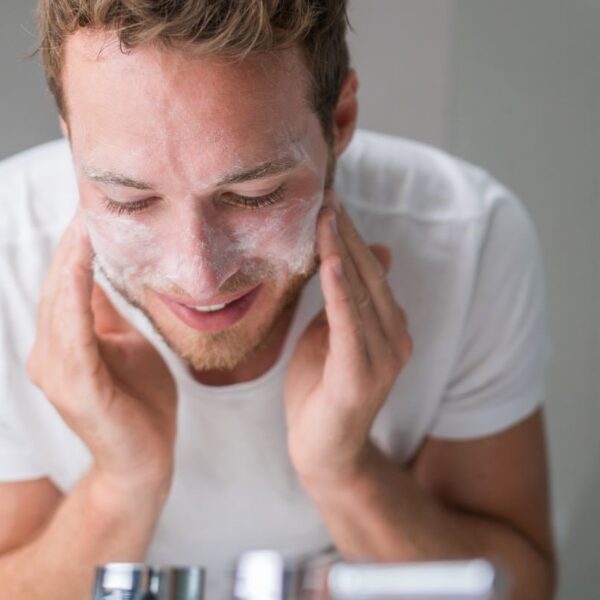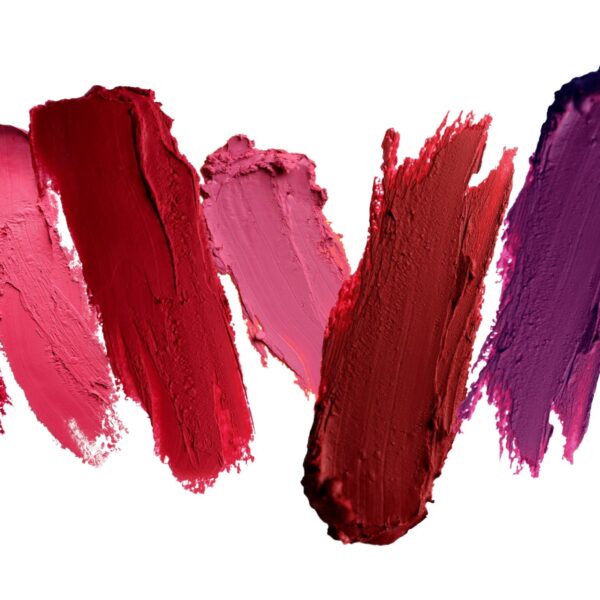Typically, the degradation of cosmetic products is either due to microorganisms being present or the product being exposed to atmospheric oxygen. To prevent spoilage, two distinct groups of preservatives are used: antimicrobial preservatives, which act on microorganisms, and antioxidant preservatives, which are capable of suppressing oxidation phenomena and the formation of free radicals.
Antioxidants are compounds or systems that can interact with free radicals and stop a chain reaction before vital molecules are harmed. In this article, we’ll focus on antioxidant preservatives, comparing five options that are popular in cosmetic product formulations today.
5 Antioxidant Preservatives
| Substance | Source |
|---|---|
| Alpha Tocopherol (Vitamin E) | Natural preservative derived from Soybean, Vegetable Oils |
| Ascorbic Acid (Vitamin C) | Natural preservatives derived from citrus and stone fruits, berries (especially acerola), peppers, and green vegetables. |
| Rosemary Extract | Natural obtained from steam distillation of rosemary leaves |
| Butylated Hydroxytoluene (BHT) | Alkylation of para-cresol with isobutylene; catalyzed by Sulfuric acid |
| Butylated Hydroxyanisole (BHA) | Mixture of 4-methoxyphenol and isobutylene |
Modes of Action for Antioxidant Preservatives
All of the antioxidant preservatives described in the table above effectively retard the onset of oxidation in products and boost the natural topical defense system against oxidation. But each preservative accomplishes its mission in a different way. Each mode of action is described below.
Rosemary Extract
Plant extracts rich in vitamins, flavonoids, and phenolic compounds can reduce oxidative damage by reacting with various biomolecules while also providing antioxidant properties.
- The antioxidant activity of rosemary extract has been mostly attributed to the two most prominent phenolic diterpenes: carnosic acid and carnosol.
- Phenolic diterpenes are known to sequester free radicals efficiently because they can form other g-lactone phenolic diterpenes that have antioxidant activity.
- Upon interacting with a free radical, carnosic acid can undergo rearrangement and form carnosol, which is also an antioxidant.
- The oxidation of carnosol results in the formation of Rosmanol.
- The formation of successive antioxidants by the oxidation of these phenolic diterpenes gives them an exceptional antioxidant capacity that can rarely be matched by any synthetic antioxidant since synthetic antioxidants are converted into an inactive form upon oxidation.
Alpha Tocopherol (Vitamin E)
Vitamin E is the most well-known fat-soluble non-enzymatic antioxidant, famous for its ability to inhibit the activity of pro-oxidant agents generated by reactive oxygen species (ROS). The antioxidant activity of vitamin E is directly linked to its ability to inhibit lipid peroxidation in unsaturated fatty acids, incorporating itself into cell membranes.
- The antioxidant activity of vitamin E is due to its ability to react mainly with the peroxyl radical (HOH•) and singlet oxygen (1O2), which favors lipid peroxidation.
- The free radical scavenging reaction occurs through the formation of a stable, low-energy radical, Tocopheroxyl, which does not have the capacity to react with the free radical-forming agent.
- Alpha-tocopherol is the main agent capable of removing Peroxyl radicals from lipid membranes and low-density lipoproteins (LDLs).
- α-Tocopherol, the most abundant antioxidant in LDL, can act as a chain-breaking antioxidant by scavenging highly reactive lipid peroxyl and alkoxyl radicals, which otherwise would propagate the chain reaction of lipid peroxidation.
Ascorbic Acid (Vitamin C)
Ascorbic acid is popularly acclaimed as a potent antioxidant and free-radical scavenger, yet the chemical basis for its remarkable behavior is poorly understood. Ascorbic acid provides protection against oxidative stress-induced cellular damage by scavenging of reactive oxygen species (ROS), vitamin E-dependent neutralization of lipid hydroperoxyl radicals, and by protecting proteins from alkylation by electrophilic lipid peroxidation products.The reaction between Ascorbic acid and Free radicals results in the formation of dehydroascorbic acid (C6H6O6) and hydrogen peroxide (H2O2), as well as reduced free radicals (R-H). The reaction helps to neutralize the free radicals, which in turn helps to preserve the cosmetic product and prevent it from spoiling. The nature of the fully oxidized species dehydroascorbate is crucial to the free-radical scavenging properties of ascorbic acid.
BHT
The primary function of phenolic antioxidants is to delay the self-oxidation of unsaturated oils that could influence the color and odor of a product.
- BHT behaves as a synthetic analog of vitamin E, primarily acting as a terminating agent that suppresses autoxidation (a process where unsaturated (usually) organic compounds are attacked by atmospheric oxygen).
- BHT stops this autocatalytic reaction by converting peroxy radicals to hydroperoxides and by donating a hydrogen atom.
BHA
BHA consists of a mixture of two isomeric organic compounds: 2-tert-butyl-4-hydroxyanisole and 3-tert-butyl-4-hydroxyanisole.
- Prepared from 4-methoxyphenol and isobutylene.
- The conjugated aromatic ring of BHA is able to stabilize free radicals, sequestering them.
- By acting as a free radical scavenger, further free radical reactions are prevented.
Other Functions of Vitamin E, Vitamin A, Rosemary Extract, BHT, and BHA
Each of the antioxidant preservatives described in this article offer several additional benefits beyond their preservative capabilities. These functions are described in the table below.
| Substance | Functions |
|---|---|
| Alpha Tocopherol | Neutralizes free radicals, moisturizing, anti-aging |
| Ascorbic Acid | Anti-aging, pH adjuster, anti-pigmentation, photoprotection, skin lightener |
| Rosemary Extract | Fragrance ingredient, free radical scavenger, anti-aging, skin tonic |
| BHT | Stabilizer |
| BHA | Stabilizer |
Chemical Properties
The following table breaks down the chemical properties of each antioxidant preservative.
| Substance | Alpha Tocopherol | Ascorbic Acid | Rosemary Extract | BHT | BHA |
| Physical form | Liquid | Solid | Liquid | Solid | Waxy Solid |
| Appearance | Yellow-brown viscous liquid | White to pale yellow crystals or powder | Transparent liquid to slightly turbid | White to Off-White Crystalline or Granular Powder | Crystals Flakes, Pastilles |
| Molecular Weight g/mol | 430.71 g/mol | 176.124 g/mol | 360.3 g/mol | 220.356 g/mol | 180.247 g/mol |
| Chemical Formula | C29H50O2 | C6H8O6 | C18H16O8 | C15H24O | C11H16O2 |
| Odor | Characteristic | Odorless | Characteristic | Faint, Slight Phenolic Odor | Faint Characteristic Odor |
| pH (1% Solution) | 2.5- 5 | 3-5 | |||
| Solubility | Insoluble in water, Soluble in Oil, Alcohol, Ether, Acetone | Soluble in Water | Soluble in water, glycerin | Insoluble in water, Soluble in Oils, Fats | Insoluble in water, Freely soluble in ethanol, methanol, propylene glycol; soluble in fats and oils |
| Boiling Point | 200 to 220 °C | 552.7 °C | 694.7 °C | 265 °C | 264 to 270 °C |
| Melting Point | 2.5 to 3.5 °C | 190 to 192 °C | 171-175 °C | 69-73 °C | 48 to 55 °C |
| Density | 0.950 g/cm3 | 1.694 g/cm3 | 0.908 g/mL | 1.048 g/cm3 | 1.0587 g/cm |
| Storage Requirement | Cool, Dry, well-ventilated place at 15-30 ℃) | Protect from contact with light, heat, and moisture. Store in a tightly closed container at 25°C. It is best to use the entire contents of the pack after opening. | Store in closed vessels at room temperature, and protect from direct light and humidity. No toxic effect of cutaneous irritation or sensitization has been reported. | Store in its original package, tightly sealed in a cool (46-90°F) and dry location out of direct heat and light. | Store in its original package, tightly sealed in a cool (46-90°F) and dry location out of direct heat and light. |
| Shelf Life | 24- 36 months | 24- 36 months | 18 months | 24- 36 months | 24- 36 months |
Formulation Considerations
Due to differing properties, each preservative has certain effects on the product it’s added to. Consider the following when using these antioxidant preservatives in food product formulas.
| Substance | Alpha Tocopherol | Ascorbic Acid | Rosemary Extract | BHT | BHA |
|---|---|---|---|---|---|
| pH Range Compatibility | 3-7 | 5-6.5 | 4-6.5 | </=9 | </=9 |
| Heat Stability | The antioxidant activity of α-tocopherol is practically constant in the temperature range from 80 to 110 °C and decreased with increasing temperature at temperatures higher than 110 °C. | Ascorbic acid has thermal stability up to 85-95°C. | Rosemary Extract has high thermal stability up to 300°C. | BHT is effective as an antioxidant up to 175°C. | BHA is effective as an antioxidant up to 150°C. |
| Recommended Dosage (%) | 0.1-1% | 0.5-2% | 0.5-5% | -Mouthwash products: up to 0.001% -Toothpastes: up to 0.1% -Other leave-on and rinse-off products: up to 0.8%. | Maximum concentration is 0.02% |
| Formulation guidelines | To be added at a less temperature around 35-40°C | To be added at a less temperature around 35-40°C | To be added at a less temperature around 35-40°C stabilizing the product | In direct addition, the fat or oil is heated to 60–70°C and the BHT is added slowly under vigorous agitation | In direct addition, the fat or oil is heated to 60–70°C and the BHA is added slowly under vigorous agitation |
Applications of Vitamin E, Vitamin C, Rosemary Extract, BHT, and BHA
| Substances | Top Applications |
|---|---|
| Alpha Tocopherol | -Hair care: Hair oils, hair masks -Body & face care: lotions, creams, body oils -Suitable especially for the anhydrous systems such as stick preparations, balms etc. |
| Ascorbic Acid | -Skincare: Skin serums, anti-aging preparations -Body & face care: lotions, creams. |
| Rosemary Extract | -Fragrance -Cleansers: face wash, liquid and bar soaps, body wash. -Hair care: shampoos, conditioners -Skincare: face mists, facial cleansers, toners, astringents, makeup removers, body mists -Anti-aging: serums, creams, lotions |
| BHT | -Hair care: Hair masks containing a large amount of refatting agents, emollient system, conditioners -Body & face care: lotions, creams, body butters -Make-up: foundations, eyeliners, mascaras, lipsticks -Suitable especially for the anhydrous systems such as stick preparations, balms -Sun products: sunscreens, suntans, aftersuns. |
| BHA | -BHA is used in various cosmetic products, including formulas containing fats or in aqueous emulsions containing certain active ingredients or plant extracts. -It is an antioxidant used in products to stabilize and protect the raw materials. -It can resist high temperatures (unlike some natural antioxidants) – It is also added with precious active ingredients like Retinol which is extremely heat sensitive, thus helping in stabilizing the active ingredients. |
Safety & Regulatory Considerations
| Substance | Alpha Tocopherol | Ascorbic Acid | Rosemary Extract | BHT | BHA |
|---|---|---|---|---|---|
| INCI Name | Tocopherol | Ascorbic Acid | Rosmarinus Officinalis Extract | Butylated HydroxyToluene | Butylated HydroxyToluene |
| CAS No. | 10191-41-0 | 50-81-7/ 62624-30-0 | 84604-14-8 | 128-37-0 | 25013-16-5 |
| EC No. | 200-412-2 | 200-066-2 / 263-644-3 | 283-291-9 | 204-881-4 | 246-563-8 |
| E number | E307 | E300 | E 392 | E 320 | E 320 |
| US Regulations | – GRAS listed – Included in the FDA Inactive Ingredients Database (IV injections, powder, lyophilized powder for liposomal suspension; oral capsules, tablets, and topical preparations) | -GRAS listed – Included in the FDA Inactive Ingredients Database (inhalations, injections, oral capsules, suspensions, tablets, topical preparations, and suppositories) | -Generally recognized as safe (GRAS) by the FDA as an essential oil, oleoresin (solvent-free), and natural extractive (including distillates) for human consumption | -GRAS listed -Included in the FDA Inactive Ingredients Database (IM and IV injections, nasal sprays, oral capsules and tablets, rectal, topical, and vaginal preparations) | -GRAS listed -Included in the FDA Inactive Ingredients Database (IM and IV injections, nasal sprays, oral capsules and tablets, and sublingual, rectal, topical, and vaginal preparations) |
| European Union Cosmetic Regulation (EC) | Accepted in Europe as a food additive | Accepted in Europe as a food additive | Accepted in Europe as a food additive | Accepted in Europe as a food additive | Accepted in Europe as a food additive |
| UK & Canada Regulations | -Included in the Canadian List of Acceptable Non-medicinal Ingredients – Included in nonparenteral medicines licensed in the UK | – Included in medicines licensed in the UK -Included in the Canadian List of Acceptable Non-medicinal Ingredients | -Included as acceptable ingredients and licensed in the UK – Included in the Canadian List of Acceptable Non-medicinal Ingredients | -Included in nonparenteral medicines licensed in the UK – Included in the Canadian List of Acceptable Non-medicinal Ingredients | -Included in nonparenteral medicines licensed in the UK -Included in the Canadian List of Acceptable Non Medicinal Ingredients |



